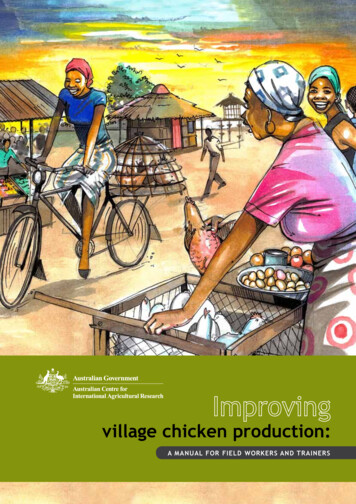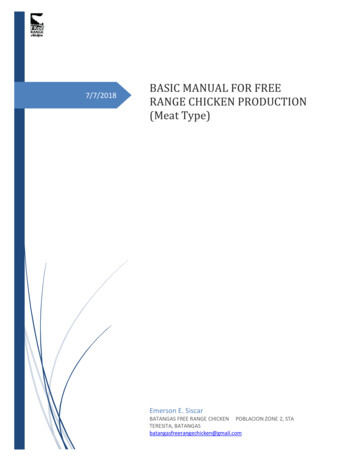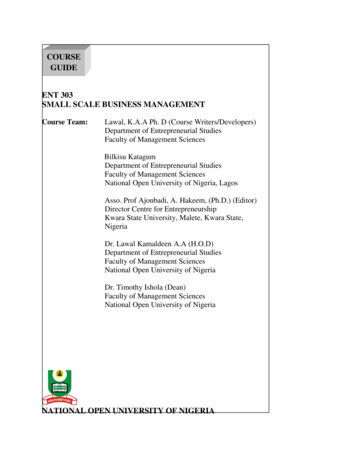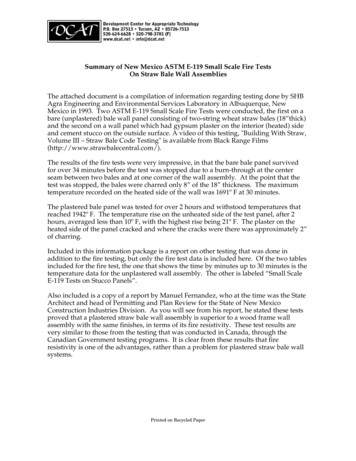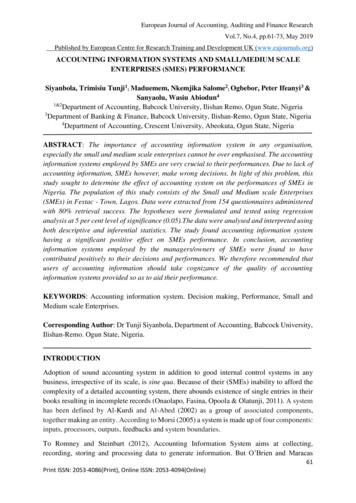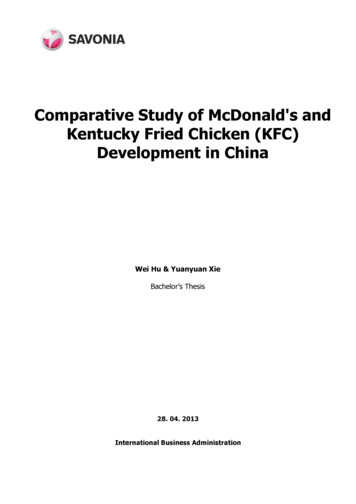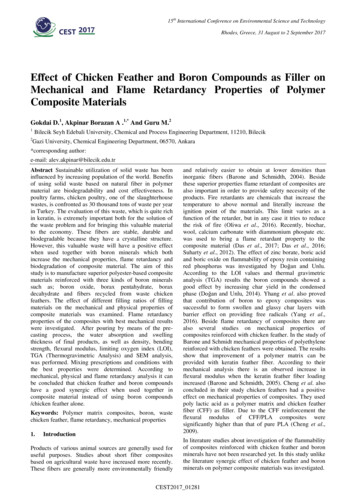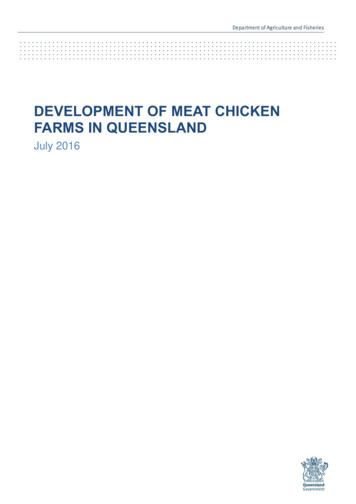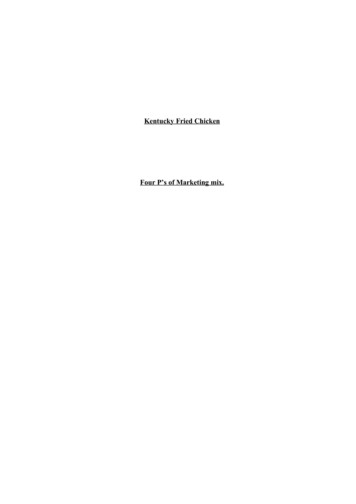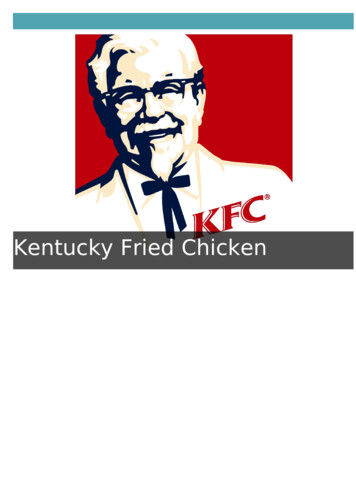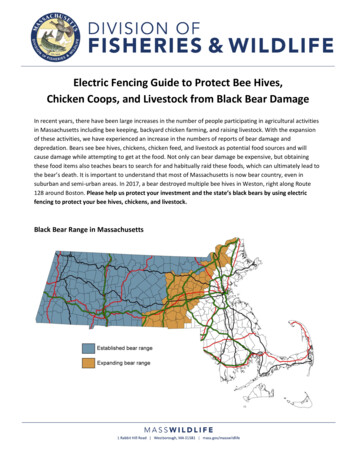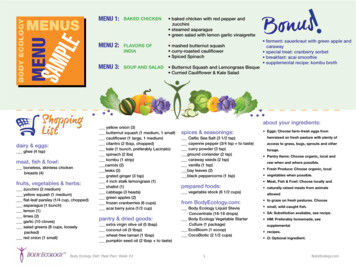
Transcription
Agrodok 4Small-scalechicken productionN. van EekerenA. MaasH.W. SaatkampM. Verschuur
This publication is sponsored by the World's Poultry Science Association (WPSA) Agromisa Foundation and CTA, Wageningen, 2006All rights reserved. No part of this book may be reproduced in any form, by print, photocopy,microfilm or any other means, without written permission from the publisher.First edition: 1990Fourth revised edition: 2006Authors: N. van Eekeren, A. Maas, H.W. Saatkamp, M. VerschuurEditors: F. W. Aqhdam, J. BolandDesign: J. BolandTranslation: I. Guijt, W.J. Guijt; C. McGregor (editing)Printed by: Digigrafi, Wageningen, The NetherlandsRevised by: G. W. Bouwman, G. de Lange and I. PulsISBN Agromisa: 90-8573-069-4ISBN CTA: 978-92-9081-347-7
ForewordThis Agrodok provides a wealth of useful information on how to overcome the main constraints in small-scale poultry production and dealwith threats like predation and infectious diseases. It is a practicalbooklet with chapters on hatching, housing, nutrition and health. I sincerely hope and believe that the knowledge, tools and experiences offered here will be a valuable resource for poultry keepers. Above all, Ihope that it will inspire readers to generate new ideas through applying the ideas they find here.Chickens deserve to be treated well – and professionally. You will seethat the birds will show their gratitude by improving their performance! I wish you a healthy flock and a successful enterprise!Dr. René P. KwakkelWageningen University - Poultry Nutrition ResearchThis edition has been revised by Ineke Puls, Gert Wouter Bouwmanand Gert de Lange of PTC , Barneveld, under the guidance of FarzinWafadar Aqhdam. Agromisa kindly acknowledges their contributionsand critical comments. We also acknowledge the financial support ofthe World’s Poultry Science Association, which made it possible topublish this Agrodok in several languages.A number of illustrations used in this Agrodok derive from the Network for Smallholder Poultry Development (‘Poultry Network’),USDA Animal and Plant Health Inspection Service (APHIS) and theNewcastle Disease Field Guide by Alders and Spradbrow (ACIAR).The nutrition tables were provided by PTC and are based on a varietyof sources.Jeroen BolandAgromisaForeword3
Contents1Introduction22.12.22.3Chicken breedsCommercial and hybrid breedsLocal breedsChoosing a chicken breed88101133.13.23.3HousingFree-range chickensSmall-scale housingSome housing options1314171944.14.24.34.4Housing equipmentFeedersDrinkersPerchesLaying ergy requirementsProtein requirementsVitamin requirementsMineral requirementsOther ingredients in chicken diets3334343637373966.16.26.36.4Feeding methodsFeeding in various housing systemsFeed intakeRestriction of energy intakeFeed composition404041444546Small-scale chicken production
77.17.27.37.4Health careInfectious diseases and their causesHygiene and biosecurityVaccinationParasites and feather pecking494953565888.18.28.3Hatching and raising chicksHatching using brooding hensArtificial hatchingRaising the chicks6060616299.19.2Improving local chickensCock exchange programmesCulling65656510Products and by-products6711 Farm records11.1 Important data11.2 Cost pricing696971Appendix 1: Diseases and parasites73Appendix 2: Nutrition tables76Appendix 3: Common feedstuffs83Further reading87Internet sites89Useful addresses90Contents5
1IntroductionChickens in extensive and semi-intensive poultry production systemsaccount for more than 75% of all poultry in the South. Owned bysmallholders in rural areas, these birds provide food security and family income and play an important role in socio-cultural events.Poultry is an important farm species in almost all countries. It is animportant source of animal protein, and can be raised in situationswith limited feed and housing resources. Chickens are ‘wasteconverters’: they ‘convert’ a scavenged feed resource base into animalprotein. They are therefore by far the most important species for generating income for rural families.People raise chickens all around the world under widely varying circumstances. Their main objective is generally the same: maximumproduction for minimum costs and with minimum risks.The two main forms of keeping small-scale chicken are small-scalesubsistence farming and commercial farming. If poultry is mainly keptfor home consumption of eggs and meat, costs and effort can be keptto a minimum. But for a poultry enterprise to be successful, it musthave a reliable market for its products and a steady supply of reasonably priced quality feed. It is important that feed resources are locallyavailable. See figure 1.This Agrodok refers mainly to semi-intensive farming. It can help beginners and experienced poultry raisers to solve problems that comeup. Its focus is on keeping layers. Keeping broiler poultry presentsdifferent problems and requires particular expertise. Nevertheless,some attention will be paid to keeping cocks as these have to be fattened too.6Small-scale chicken production
Figure 1: A chicken breeder has to reflect on many subjectsThis booklet deals with housing, chicken feed, health issues, naturalbreeding and raising chicks and administration.Introduction7
2Chicken breedsAll over the world, more than 300 breeds of the domestic chicken species (Gallus domesticus) exist. We distinguish three main categories ofchicken breeds: pure commercial breeds, hybrid breeds resulting fromcross-breeding, and local breeds or land races.We can roughly divide commercial breeds according to their mainproduction aim:? egg laying, mainly with lightweight laying breeds or layers? meat production, mainly by heavyweight breeds or broilers? both egg-laying and meat production by so-called dual-purposebreeds.Layer, broiler and dual purpose breeds can be distinguished accordingto their shape. See figure 2.Figure 2: Typical breeds: (a) layer (b) broiler (c) dual purpose(Poultry Network)2.1Commercial and hybrid breedsA wellknown lightweight layer breed is the White Leghorn (figure 3).White Leghorns are known for laying lots of white eggs. They needless feed, due to their small size. White Leghorns are therefore veryefficient layers. At the end of the laying period they give relativelylittle meat.8Small-scale chicken production
Some heavier layer breeds are meatierand still lay many eggs. These arehence fit for dual-purpose production.These chickens lay brown eggs andusually have brown feathers, but thiscan vary per breed. We mention thebrown-coloured Rhode Island Red(figure 4) and the light-brown NewHampshire (figure 5). These are keptfor both meat and egg production andcan hence be categorized as dualpurpose breeds. Heavier dual-purposebreeds are very suited to small-scalechicken raising in the tropics. Theyare usually sturdier than the light Figure 3: White Leghornbreeds.Medium-weight and heavy chicken breeds are raised for meat production. Cocks of medium-weight chicken breeds can also be kept forslaughtering. Breeds like White Cornish and White Plymouth Rockare important meat producer breeds and hence better suited as purebroiler chickens.Figure 4: Rhode Island RedChicken breedsFigure 5: New Hampshire9
These heavier birds have more muscle. They grow fast and can quickly reach a high slaughter weight. This requires plenty of high qualityfeed. It requires special skills to keep this in good supply and balance.Hybrids or cross-breeds result from combining special lines or strainsof chickens developed for this purpose with e.g. a local breed. Thehybrids are more productive. In countries in the South, cross-breedingbetween pure breeds is also common, e.g. White Leghorn crossed withRhode Island Red. Nowadays hybrid breeds have become very common.2.2Local breedsIf you want to breed your own stock of chickens, you cannot go onusing the hybrid breeds, as their high productivity will go down. Youcan only get high production with hybrid layers if you buy chickensregularly. It is therefore advisable to use local breeds, which are oftenmuch cheaper to keep. Another advantage of local chicken breeds isthat they are better adapted to local conditions and are less susceptibleto diseases than the more fragile hybrids. Local breeds are usuallylighter in weight and have smaller eggs than those of hybrid breeds.Local breeds can be distinguished according to their appearance. Seefigure 6.Figure 6: Local breed types: (a) frizzle feather (b) naked neck (c)dwarf (Poultry Network)10Small-scale chicken production
However, local chickens are far less productive in terms of egg numbers. In rural areas, local chickens lay about 50 eggs per year, whilehybrids can lay 250-270 eggs a year under favourable conditions. Onthe other hand, local breeds make better use of waste material thanhybrid chickens do, so they are more suitable for keeping around thehouse.This booklet discusses various factors influencing egg production andmethods for improving it, with the aim of reaching medium to highproduction levels.2.3Choosing a chicken breedImportant factors when choosing the best breed of chickens for yoursituation are: price, market situation, experience, farm management,local preference and availability.The price will determine your choice. Modern hybrids are very expensive. They also need very good care and high quality, balanced feed tobe productive. Local breeds are cheaper and better adapted to localconditions. With adequate care, they are reasonably productive. However, if you want to raise chickens on a larger scale and decide to buybalanced feed, it is better to choose the more expensive hybrids.It is important to consider the local market situation. Medium-weighthybrids should only be chosen if there is a good market for eggs andmeat and a steady supply of good, balanced chicken-feed. If you wantto concentrate on selling eggs, consider buying lighter, white layers. Inall other situations, the heavier, usually brown breeds would be a better choice. If you live far from a market and mainly want to producefor home consumption, only selling extra eggs and meat locally, youare best off with a local breed.If you have no experience of raising chickens, it is best to start with acheaper, local breed.Chicken breeds11
If farm management is good, you can buy the more expensive andprofitable hybrids.In some countries local preference favours brown eggs.Hybrids are not always locally available, so you will be dependent onwhat can be obtained in your area.12Small-scale chicken production
3HousingWe distinguish three forms of chicken farming:? extensive farming? intensive farming? semi-intensive farming.In this Agrodok, we mainly refer to the extensive and semi-intensivefarming. Intensive farming with e.g. battery cages will not be treated.When chickens are free to roam and scavenge, we talk about extensive, free-range chicken farms. The level of capital and labour investment is low. Housing is not important.Intensive systems, developed for specialised breeds, are estimated tobe in use for about 30% of the poultry population in Africa. These aremainly found in and around urban areas with good markets for eggsand chicken meat. Intensive chicken farms require more investment ofboth capital and labour, e.g. special poultry houses with runs or roaming space. Flock sizes in intensive production are normally in thethousands. This has been made possible by research developments inartificial incubation, nutritional requirements and disease control.In the semi-intensive production system, also known as backyard production, flocks range from 50 to 200 birds. A lot of techniques andexpertise developed in intensive systems can be applied in semiintensive poultry raising systems, adapted to the adequate scale.In both the semi-intensive and intensive production systems, housingis very important for optimal production levels. See sections 3.2 and3.3.Housing13
3.1Free-range chickensIn the free-range system, chickens are free to roam the farm in searchof food. Eggs are laid outside in simple nests and are mainly used tomaintain chicken numbers. In many cases, up to 75% of the eggs haveto be hatched because the mortality rate among baby chicks is high.Few eggs remain for consumption and the chickens themselves do notgive much meat.The advantages of this system are that little labour is needed andwaste food can be used efficiently. Very low costs can offset low production levels so that keeping chickens around the house can be profitable if certain improvements are made.The free-range system is most suitable if you have a lot of space, preferably covered with grass. At night, the chickens can be kept in anykind of shelter, as long as it is roomy, airy and clean. This will minimise the loss of chickens to illness or theft. If you have enough spacefor the chickens to roam freely, a mobile chicken house is best. Oneexample of this type of housing is shown in figure 7.Figure 7: A simple mobile chicken houseThe spread of infection by parasites in chicken faeces can be prevented by using a raised night shelter with an open floor made ofchicken-wire, wooden slats or bamboo sticks 5 cm apart. This willalso keep the chickens safe from predators. If you want to maximise14Small-scale chicken production
the number of eggs, train mature layers to use laying nests in thechicken house early in the laying period. Place the laying nests in thechicken house before the chickens start laying, and keep them in a bitlonger in the morning. Remember to provide fresh drinking water.To limit mortality among baby chicks in the free-range system, takesteps to protect the mother hen and the chicks from predators, thievesand rain. Put them in a simple, separate shelter that is roomy and airyand can be closed securely. Draughts and low temperatures during thefirst few days are particularly dangerous for the baby chicks. Althougha run is handy, it is also risky, due to possible worm inf
sive, free-range chicken farms. The level of capital and labour invest-ment is low. Housing is not important. Intensive systems, developed for specialised breeds, are File Size: 636KBPage Count: 91
